5/5/2020 9:49:01 AM
By John Gruchy and William T. McKinley
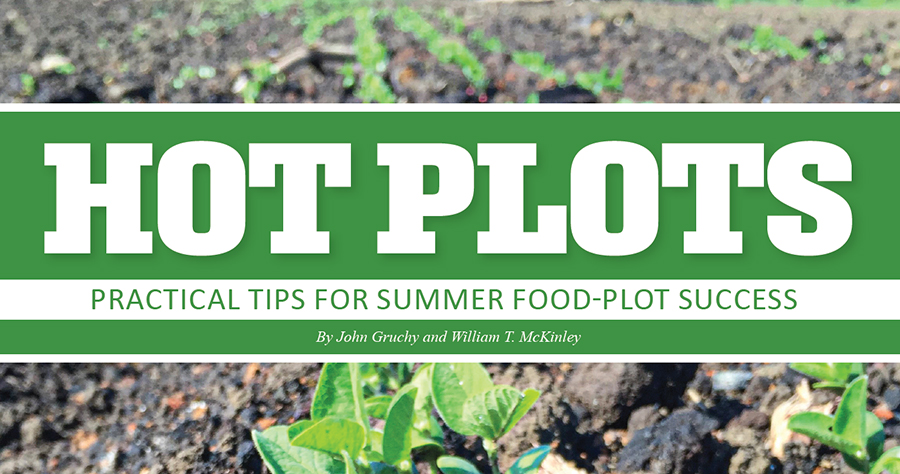
Beyond the occasional dove field or corn patch, many Mississippi hunters tend to shy away from summer plantings as a wildlife management activity. Who could blame them? Summer plantings can be far more challenging to manage than winter plots because of oppressive heat and weed pressure in the South, not to mention the added expense. But these hunters are missing out.
Why plant summer forage plots
White-tailed deer management is a game of nourishment. The game consists of getting nutrients from the soil and energy from the sun into deer bellies through plant tissues, fruits, and nuts. The playing field can be comprised of native vegetation and supplemental plantings. The primary means of improving native foods is through habitat-management practices, including prescribed burning, forest management, and soil disturbance. Often these management practices produce a pulse of nutrition for deer that can be short-lived and should be considered part of an overall management strategy. Perhaps most importantly, habitat-management practices that improve native plant communities for deer also tend to result in better food and cover for many other species of wildlife, including wild turkey and small game.
Supplemental plantings play a role in the nourishment game by providing in-creased forage production and quality on a per-acre basis compared to the native plant community. It is especially so during the late-winter and late-summer nutritional stress periods when native browse is often scarce or of poor quality because of the natural ebb and flow of the annual cycle.
Annual summer food plots, particularly those that consist of forage legumes such as soybeans, cowpeas, or American joint vetch, tend to address the late-summer nutritional stress period for deer much more effectively than the perennial white clovers (e.g., Duranna or Ladino) upon which many hunters rely. For instance, during the nutritionally taxing month of August when native forages can offer as little as 6% crude protein, the low end of a deer’s nutritional requirement, a drought-stressed perennial clover plot could produce around 500-1,000 pounds of forage per acre (dry weight). In contrast, a cowpea food plot could produce as much as 4,000 pounds of forage per acre (dry weight) at 22% crude protein. Most importantly, summer food plots intended to boost deer nutrition can also produce an excellent brood-rearing cover for turkey and bobwhite, as well as a seed resource later in the fall.
Common sense tips for success
For some Mississippians, time spent on the farm is an everyday affair; where-as for most, interacting with the land through planting crops or managing livestock is a treasured memory. In either case, the pastoral wisdom of the farm is familiar: Crops need nutrients, water, and sunlight; a particular plot of land is best suited for certain crops, and unwanted weeds can hurt crop production. Similar-ly, summer forage plots for white-tailed deer should be planted on an appropriate site, with a proper crop, and managed to control weeds.
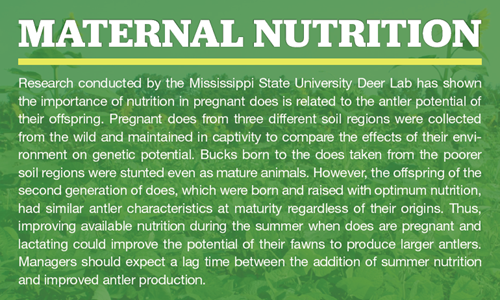
Choose the right site and amend the soils properly
Summer crops need moisture. As such, many sites that can be too wet to plant in the winter might work fine for summer crops. In addition to prior experience with the soils on a property, web-based tools, including Web Soil Survey (web-soilsurvey.sc.egove.usda.gov), can be great resources to discern soil productivity and drainage.
The importance of soil testing cannot be overstated. Forage legumes grow best when soil pH is between 6.5 and 7.0, with approximately 75 units of phosphorus and 240 units of potassium per acre available. Soil testing provides a prescription for amending soils with lime and/or fertilizers to meet these requirements. Modifying soil pH by adding lime is not an instant process, so advanced planning could be beneficial. Lastly, many forage legumes have bacteria associated with their roots that can utilize atmospheric nitrogen to feed the plant. In the case of these legumes, the bacteria they need are not typically found in our soils, especially when planting new sites. Speak with your local seed provider about legume inoculation or contact the Mississippi State University Extension Service (extension.msstate.edu) for more information.
In addition to soil properties, another vital consideration when selecting a site for a summer forage plot is the size of the plot relative to the deer herd in the area. In many areas, summer forage plots smaller than one acre will have no chance of getting ahead of deer browse pressure. Generally, plots of three to five acres in size are best when using most forage legumes. The shape or orientation of the plot is generally irrelevant in terms of deer utilization as long as sunlight is not limiting. However, hunting scenarios should be considered, especially where early bow season opportunities are a priority. 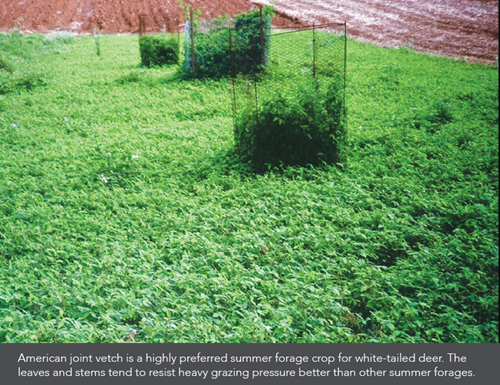
Choose the right forage
Most commercially available summer forages, including forage soybeans, cowpeas, lablab, Quail-Haven soybeans, American joint vetch, and alyceclover, produce tons of high-quality food during the late-summer nutritional stress period for deer. The trick to selecting the right cropping strategy comes down to the balance of available acreage to plant, deer herd density, and the weed context of the fields in question.
Deer enthusiasts and rowcrop farmers will agree, there is perhaps no other plant as treasured by white-tailed deer as a soy-bean. Unfortunately, soybeans do not resist browsing particularly well. While land managers who have managed their herds to a moderate density and have the luxury of three- to five-acre plots to work with can utilize the crown jewel of summer forages without concern of overgrazing, many hunters might wish to select a for-age with more tolerance for grazing. Generally, cowpeas, Quail-Haven soybeans, and lablab are more browse resistant than soybeans and tend to climb well on companion crops, such as sunflowers or grain sorghum, potentially improving browse production. American joint vetch and alyceclover tend to be the most browse-tolerant forages, although they also tend to carry the highest establishment costs.
Some managers prefer to establish mixtures of forage legumes and grains, like corn or millet, to provide more structure and potentially add grain production. While it is usually a good idea to mix two or more forage legumes to provide a hedge against crop failure and to stagger peak performance, hunters should consider their objectives and weed context before committing to complicated mixes of grains and forages. Grasses tend to be the least preferred of all vegetation classes in terms of white-tailed deer forage. Furthermore, the most aggressive summer weeds in our climate tend to be grasses. Therefore, more compatible companion crops for forage legumes may include sunflowers (where deer density is moderate) and grain sorghum treated with seed safener to allow for selective herbicide applications to address grass weed problems.
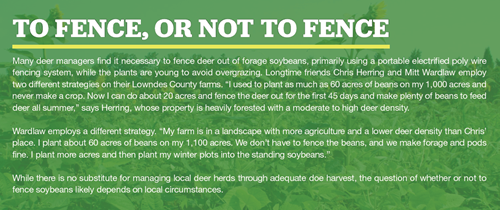
Choose the right weed-control strategy
The widespread availability of glyphosate-resistant crops changed weed control as we know it. For deer forage crops, glyphosate-resistant varieties of soybeans and corn can be options to consider for their flexibility with broad-spectrum chemical weed control. As mentioned above, soybeans are not always the best choice for every site. Other summer forages like cowpeas and joint vetch do not have glyphosate-resistant options. Conventional soybean herbicides, such as imazethapyr and metolachlor, can work with certain crops for preemergence weed control. At the same time, postemergence chemicals like clethodim and sethoxydim can be used to control grass weeds as long as a grass crop like corn or milo is not included in the planting mix. Always read label recommendations before using herbicides.
Putting it all together
Implementing these recommendations is not as difficult as it might seem. Select sites for summer plantings based on soil moisture and plot size, then test and amend soils appropriately. Depending on site characteristics and individual landowner goals, a good mix might include soybeans, cowpeas, and joint vetch, with a companion crop of corn or grain sorghum treated with an antidote. An application of metolachlor herbicide at the time of planting will help control many weeds until the plants become large enough to compete with residual weed pressure (if browse pressure is not too high). If grass weeds are expected to be a problem, perhaps trade the corn or grain sorghum companion crop for sun-flowers, then apply the grass-selective herbicide clethodim as needed through-out the growing season. Where plots are small or browse pressure is expected to be heavy, plant American joint vetch or a mix of joint vetch and alyceclover with a preemergence application of imazethapyr to control weeds during establishment. Next, use clethodim as needed to control grasses throughout the summer.
Focusing efforts on summer nutrition, through sound habitat management and supplemental summer forage plots, is an excellent strategy to maximize the benefits of money spent on management where antler production is a high-priority objective and multiple-species management is essential. Perhaps most importantly, summer plantings offer hunters and managers another opportunity to get their hands dirty and return to their farming roots. Remember to pay attention to the planting location and select the right mix for your deer density and weed context.
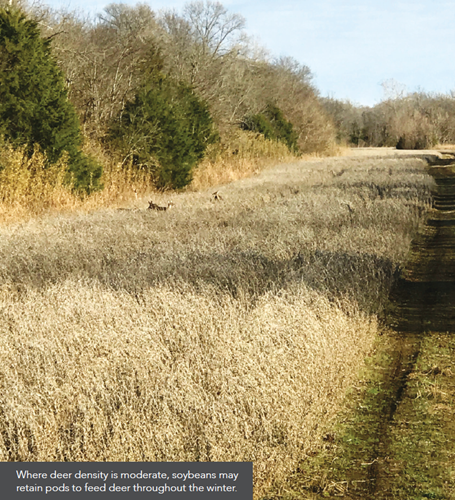
For more information about habitat management and supplemental plantings, set up a free site visit with an MDWFP Private Lands Biologist at www.mdwfp. com/privatelands.
William T. McKinley is the Deer Program Coordinator, and John Gruchy is the Private Lands Coordinator for MDWFP.









